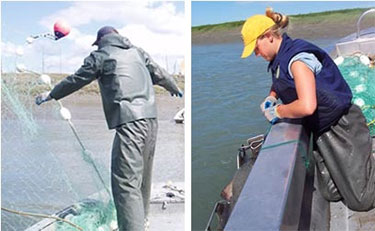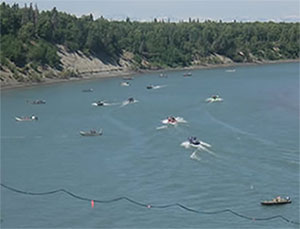
Kenai (RM 14) River
Other Tools
Other Tools

Sonar is only one source of information ADF&G uses to gauge Kenai River king salmon run strength. It also uses information from non-sonar sources including inriver gillnets, sport fishery catch rates, and commercial harvest, as indicators of king salmon abundance.
Inriver Gillnets
In the lower Kenai River at River Mile (RM) 9, ADF&G crews drift gillnets every day from mid-May to mid-August. To minimize injuring king salmon, they use undersized mesh nets and never remove captured king salmon from the water. The crew collects information that includes fish species, length, and sex, as well as scale samples to determine age. Catch rates provide biologist with an indication of run strength. Data on fish length and the relative proportion of large kings, small kings and sockeye in the gillnet catches helps biologists determine post season how many small, sonar-detected fish should be classified as king salmon rather than sockeye salmon.

Sport Fish Catches
Using what is called a creel survey, ADF&G technicians count and interview anglers on the Kenai River throughout the sportfishing season to estimate king salmon harvest and sport fishery catch rates. Fisheries managers use the catch rates as an indicator of abundance, while recognizing potential biases due to unfavorable fishing conditions. King salmon are less likely to bite, for example, when water temperatures change suddenly and when high levels of turbidity make it difficult for king salmon to see lures.
Commercial Eastside Setnet Harvest
As another indicator of run strength, ADF&G also collects information in Cook Inlet about the commercial East Side Setnet king salmon harvest from information setnet fishermen provide on fish tickets. This information is used as an indicator of abundance for the late run king salmon only. In addition to run strength, the commercial king salmon harvest is also influenced by other factors such as how intensively East Side Setnet fishermen are fishing in the inlet, which generally correlates with how big the sockeye run is.
| Gauging Run Strength: The estimates and primary indicators managers use to assess Kenai king salmon |
|
|---|---|
|
|
| The department reports all of these sources of information on its Kenai king salmon count page. | |
SSART Estimates of Abundance
For the years 2007 to 2014 ADF&G produced stock-specific abundance and run timing (SSART) estimates for Kenai River king salmon. The SSART model used genetic stock identification (GSI) data from the inriver netting and creel programs to estimate stock composition of the inriver run and harvest respectively. Other model inputs included estimates of passage from tributary weirs (Funny, Killey, and Russian rivers, and Slikok, Quartz, and Grant creeks), estimates of inriver harvest from the onsite creel survey and the ADF&G statewide harvest survey (SWHS), spawning destinations of radio tagged Chinook salmon, and daily catch per unit effort from the inriver netting project. SSART model estimates of abundance for all king salmon regardless of size were produced for the years 2007 to 2012 [ Reimer et al. 2016]. SSART model estimates of abundance for king salmon 34 inches in length and longer were produced for the years 2007 to 2014 [Reimer and Fleischman 2016]. SSART estimates compared favorably with RM 14 sonar estimates.
